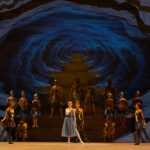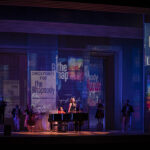What better place to stage the first North American production of a play about William Shakespeare than at the continent’s longest running Shakespeare festival? This was the thinking behind the Stratford Festival’s summer 2016 production of Shakespeare in Love, the glorious romp that brings the 1998 Oscar-winning film of the same name to the stage. Produced in Stratford, Ontario, by special arrangement with The Walt Disney Company and Sonia Friedman Productions, the show’s script, set and costume designs come directly from the Noel Coward Theatre in London’s West End, where it debuted in June 2014.
Marc Norman and Tom Stoppard’s wry and witty movie script got its makeover for the stage from Lee Hall, the writer best known for the Tony-winning script for Billy Elliot: The Musical. Hall’s adaptation closely follows the film, weaving a tale with all of the preposterous ins and outs of the original — and does so, in fact, without losing more than a few lines of the movie’s snappy, energetic dialogue or a single quote from the Bard’s own lexicon.
The blast of ingenuity, then, is in reimagining this play for the stage. Director Declan Donnellan and designer Nick Ormerod are joint founders of the venerable Cheek By Jowl theatre company in London, and they have staged a wide range of Shakespeare’s works, setting many of them in environments well beyond the century in which they were written. In approaching Shakespeare in Love, however, the creative team planted their feet firmly in the Elizabethan era, with not so much as a button out of place.

Three Stories and a Movable Bridge
The West End production featured a set that echoed the architecture of the original Globe Theatre in London, where Shakespeare’s plays were first performed. The three-level set not only places us on the Bard’s own stage, but it becomes half a dozen other locations: We find ourselves in a ballroom in the home of Viola, the play’s heroine and Will’s newly found love; in Viola’s bedchamber — complete with a canopied and curtained bed; in a boat on the Thames River; and on the balcony from which she and Will perform the scene that inspires Romeo and Juliet. Donnellan peppers the upper levels with pairs of musicians who accompany the action on period instruments, playing music composed for the production by Paddy Cunneen.
Ormerod had a knotty problem to solve in creating one of the scenic elements: a performance space for the play-within-a-play, the actual production of Romeo and Juliet. How would he make this distinctly different from the area in which the audience sees the actors rehearse — and then switch smoothly from the performance of Romeo to the supercharged antics going on behind the scenes?
“I cogitated over that for some time,” Ormerod said in a phone interview from his office in London. “I was sitting in another theatre and it just hit me that a mobile bridge was the answer.”
With a telescoping effect that elicits gasps from the audience, a portion of the set glides downstage to create a sense of the play actually taking place in the Globe Theatre. When the action continues backstage seconds later, the bridge moves silently and smoothly back to its original place … and then repeats the move when the play continues, heightening the kinetic energy of the climactic scenes.
“That seemed to me to have the wonderful effect of bringing the Juliet balcony close to the audience, and giving maximum freedom within the balcony so she could move, not being stuck in a small space,” said Ormerod. “It seemed to me the perfect solution.”
The effect is controlled from two winches in the trap room under the stage, said Elissa Horscroft, Stratford technical director. “We have a track on either side of the stage, and there’s what we refer to as a dog that travels up and down the stage in each one,” she explained. “We have a scissor knife that goes through the bridge unit into the dog, and we bolt the set to that knife. That keeps it attached to the carrier. When the dog moves, so does the set.”
For the North American premiere, translating this design to Stratford proved to be a far simpler process than Ormerod expected. The Noel Coward Theatre in London and the Avon Theatre in Stratford turned out to be almost exactly the same size. The original set design “fit like a glove from West End to Stratford,” he said. “The measurements were almost precise.”
As Stratford would build the set from scratch, the new production gave Ormerod the opportunity to make some changes that improved the set’s structure and functionality. “In Stratford, I thought the finish was better,” he said. “We changed some wooden supports of the platforms. I would be very happy for it to continue exactly as it is now.”

The Challenges of Rotating Repertory
The Stratford production added a measure of complication, however, that Ormerod did not face in the West End: Stratford runs three plays in the Avon Theatre in rotating repertory throughout the summer. The set would have to be modified for easy strike and reassembly in a matter of minutes, with enough durability to last for the entire six-month run — all without compromising the design.
“All of our sets have to work in rep, so when we get a design, that’s one of the first things we’re trying to address — how to get it on and off the stage in less than half an hour,” said Horscroft. This summer, Shakespeare in Love ran in rep with A Little Night Music and The Lion, the Witch and the Wardrobe. “We have about an hour between shows,” so the conversion has to be swift and efficient, she said.
The 2016 season was Horscroft’s fourteenth with Stratford, so she knows all the tricks for turning a design into a movable set. “The first thing you do is decide how to divide it into pieces,” she said. “The center unit is one piece, and then you have the two side units and the two Juliet balconies that wrap around the proscenium. We separated them out, so they would come apart and go together easily.”
The size and weight of the pieces posed a challenge, but the larger problem to solve came from the structure itself. “The sides sit on columns,” she explained. “A big structure sitting on legs is okay when it’s static, and less so when it starts moving. The legs become less structural.” Placing the set on casters was one option, but Horscroft and her crew made another choice: “We built lifters, two for each side. They’re large units that slide under in the openings of the side units and lift them. We made these out of four trailer jacks, like you would use to unhitch your camper — you put an electronic jack under it to support it. Each of these jacks is rated to lift 3,300 pounds. We put them under, and on a cue, a stagehand at each one pushes a button, and it lifts at the same time. Then we stop it and wheel them away.”
The center bridge required another solution, because of the mechanism that allows it to move upstage and downstage during the performance. “When it’s on stage, it sits on straight casters,” Horscroft said — casters that only move upstage and downstage, so they become an obstacle to moving the set piece offstage. Instead, the crew uses air casters to lift the entire unit and wheel it off.
The solutions may seem straightforward, but Horscroft is quick to dispel the notion that this kind of problem-solving is easy. “What we finally ended up with on Shakespeare in Love was probably the fifth version, or even more than that,” she said. “It’s different every single time. We have to think about speed, ease, versatility for if we ever want to do something with the set down the road — if it ever needs to go into a trailer.”
Lighting In, On and Around Three Stories
Originally, Stratford expected that Neil Austin, the lighting designer from the West End production, would come to Canada to recreate his design. When he became unavailable, Kevin Fraser, one of Stratford’s resident lighting designers, stepped up. “I was already doing the other two shows in rep at the theatre,” said Fraser, “so I became the logical choice.”
Austin generously provided his plot for the original production, given that the set and much of the staging were very similar as well. Fraser, however, found that using Austin’s design would be more difficult than working from his own rep plot. “We didn’t have the same equipment available that they have in the West End,” Fraser said. “And in rep, we have to share the equipment with two other shows.”
With about 180 lights already in place in the rep plot, the Avon Theatre divides the rest of its lighting inventory between the three shows. “Shakespeare in Love had another 120 lights hung specifically for it,” he said.
Even with 300 lights in the air, however, the three-level set came with challenges of its own: Many scenes are played directly under the bridges, where conventional lighting often can’t reach. Austin had specified that lighting be built into the bridges themselves, and Fraser decided that this was the best solution. “There are RGB LED strips built into the undersides, so we can light the ground floor and the second level,” he said. “There are 50-watt birdies on the underside as well. It’s all radio-controlled, so we can successfully light on the ground and second floors.” Sidelights on the second and third floors provide necessary cross lighting.
With one scene flowing seamlessly into the next, the production relies in part on color changes in the lighting to convey a sense of place and mood. “Part of the color changes come from a system of high side light which are all SeaChangers, for dichroic color,” said Fraser. “The bulk of what you see are live color fades using the SeaChangers and cross fades between front light color washes. We use moving lights mostly to do small pools of light, and these can all color-change live as well.”
Even with 29 years as the lighting designer for Stratford, Fraser found it more complicated than he expected to produce a new lighting plot for an existing production. “The placement of the lighting cues ended up being very similar,” he said. “The colors might not be the same, though. I didn’t use Neil’s paperwork — I was deliberately not trying to copy the original production. But you have to follow the action, particularly in terms of timing and cue placement.”
So what’s next for this production? A Disney Theatrical spokesman confirmed that there are no plans for a Broadway production. Instead, Disney will license the show to professional theatres around the world, with each mounting their own distinct design. Perhaps this madcap frolic is coming soon to a theatre near you.


